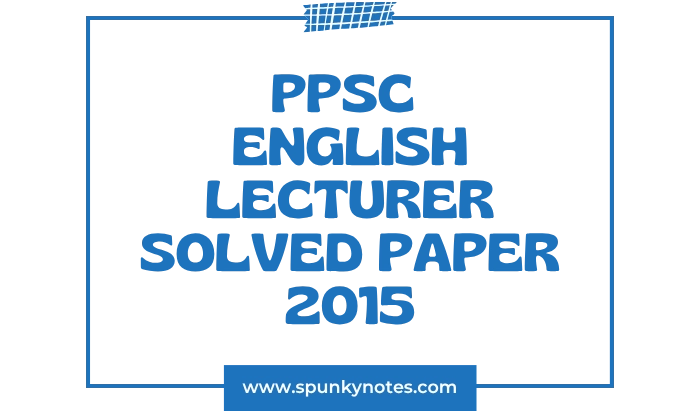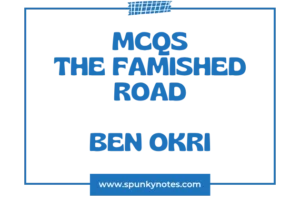

Estimated Reading Time: 23 min
🡆 PPSC English Lecturer Exam Guide
PPSC Lecturer English Paper 2015 Analysis
This analysis categorizes the available (74 out of 100) questions from the 2015 paper, which shows a strong focus on Linguistics, followed closely by Literature, and a smaller section on Grammar and Vocabulary.
Literature: 42 Questions
Linguistics: 18 Questions
Grammar & Vocabulary: 14 Questions
Part 1: Literature (42 Questions)
This was the largest section, covering a wide range of English literary history, genres, authors, and critical concepts.
Poetry & Poets (20 Questions)
Topics: A primary focus, with questions on the collaboration for Lyrical Ballads, and Byron’s death in the Greek War of Independence.
Shelley’s elegy Adonis on Keats’ death, the works and philosophies of Wordsworth and Keats, Chaucer’s The Canterbury Tales, Milton’s Paradise Lost, Sylvia Plath, and T. S. Eliot.
Drama & Dramatists (6 Questions)
Topics: Covered Shakespeare’s sonnets, the chorus in Sophoclean tragedy, characters from Ibsen’s A Doll’s House, G.B. Shaw’s influences, and Arthur Miller’s concept of tragedy.
Novel & Novelists (5 Questions)
Topics: Questions included George Orwell’s critique of the Bolsheviks and Charles Dickens’ continuation of literary traditions.
The rise of children as characters in 19th-century novels, themes in George Eliot’s The Mill on the Floss, and the historical shift from external to internal character depiction.
Prose, Authors & History (2 Questions)
Topics: Included questions on Francis Bacon’s knighthood and Pakistani writer Ahmed Ali.
Literary Terms & Theory (9 Questions)
Topics: This section focused on definitions of key concepts, including Pun, Allegory (in relation to The Faerie Queene),
Morality Plays, Tragi-comedy, rhetorical concepts such as Ethos, structural terms such as Epigraph, dramatic devices such as Aside, and literary movements such as the Theatre of the Absurd.
Part 2: Linguistics (18 Questions)
This section was heavily represented, covering technical and theoretical aspects of language study.
Phonetics, Morphology & Syntax
Topics: Included definitions of fundamental units like Morphemes, Clauses, and Sentences. It also covered phonetics (Plosives, Bilabials, Auditory Phonetics), phonology (phonemes, allophones), and morphology (Compounds).
Linguistics Terms
Topics: Tested knowledge of Fries’ utterance units, Saussure’s concepts of Language vs. Parole, Synchronic linguistics, Skinner’s Behaviorism, and sociolinguistics.
Terms like Pidgin, Creole, and Isogloss. Language teaching methods were also included.
Part 3: Grammar (14 Questions)
This section focused on practical vocabulary and sentence structure.
Vocabulary (8 Questions)
Topics: Tested knowledge of antonyms for words like Acumen, Grotesque, Zenith, Patrician, and synonyms for words like Pique, Spoken, Close shave, Paradoxical.
Grammar (6 Questions)
Topics: Included the identification of reflexive pronouns, a sentence correction task, and four “fill-in-the-blank” questions testing prepositions and logical consistency.
Summary
| Main Category | Sub-Category | Number of Questions |
|---|---|---|
| Literature | Poetry & Poets | 20 |
| Drama & Dramatists | 6 | |
| Novel & Novelists | 5 | |
| Prose, Authors & History | 2 | |
| Literary Terms & Theory | 9 | |
| Linguistics | (Phonetics, Syntax, Theory, etc.) | 18 |
| Grammar & Vocabulary | Vocabulary (Synonyms/Antonyms) | 8 |
| Grammar & Sentence Completion | 6 | |
| Total | 74 | |
PPSC English Lecturer Past Papers
PPSC English Lecturer Solved Paper 2015
1. The smallest parts of an expression associated with some meaning are called:
A. Stems
B. Morphemes
C. Suffixes
D. Prefixes
2. Name the poet, who belongs to a small group, got fame after 50 years of age?
A. Coleridge
B. Keats
C. Milton
D. Spencer
3. A group of words with its own subject and predicate, if it is included in a larger sentence is
A. Clause
B. Phrase
C. Idiom
D. Sentence
4. “A word or set of words followed by a pause and revealing an intelligible purpose” is
A. Word
B. Clause
C. Phrase
D. Sentence
5. Fries classifies utterance units into:
A. Single minimum free utterance
B. Single free utterance not minimum but expanded
C. Free utterances
D. All of these
6. A lexical unit in which two or more lexical morphemes are juxtaposed is called:
A. Idiom
B. Compound
C. Phrase
D. Clause
7. A consonant that is produced with a stricture is called:
A. Plosives or stops
B. Articulations
C. Allophonic variations
D. None of these
8. Phoneme, Phone, Allophone are the concepts of:
A. Phonetics
B. Phonology
C. Anthropology
D. Linguistics
9. The study of hearing and the perception of speech sounds is called:
A. Auditory phonetics
B. Acoustic phonetics
C. Articulatory phonetics
D. None of these
10. The set of all possible grammatical sentences in the language is:
A. Le language
B. Language
C. Parole
D. None of these
11. Who studies a language at one period in time and investigates the way people speak in a given speech community at a given point in time?
A. Synchronic or descriptive linguistic
B. Diachronic or historical linguistic
C. Both of these
D. None of these
12. How many sonnets were written by Shakespeare?
A. 152
B. 153
C. 154
D. 155
13. Name the poets who composed Lyrical Ballads (1798):
A. Keats and Coleridge
B. Keats and Wordsworth
C. Shelley and Coleridge
D. Coleridge and Wordsworth
14. Name the war in which Byron proved his rebellion by death by opposing Europeans by taking part in the war against Turks and supported:
A. Mustafa Kamal
B. Greek war
C. Persian war
D. None of these
15. Consonant produced or formed by closure or near closure of the lips is called:
A. Nasal
B. Glottal
C. Bilabial
D. Labio-dental
16. The technique used by Skinner is:
A. Structuralism
B. Functionalism
C. Behaviorism
D. Cognitive
17. When a pidgin becomes a lingua Franca, it is called:
A. Dialect
B. Idiolect
C. Creole
D. Diglossia
18. A contract language, a mixture of elements from different natural languages is called:
A. Dialect
B. Idiolect
C. Diglossia
D. Pidgin
19. On a linguistic map a line indicating the degree of linguistic change is called:
A. Dialect
B. Registers
C. Isogloss
D. Idiolect
20. Mood is related to illocutionary force. Moods are:
A. Speaker oriented
B. Subject oriented
C. Epistemic
D. All of these
21. In Sophocles, the chorus consists of:
A. 50
B. 15
C. 12
D. 11
22. A character in Doll’s House by Ibsen was?
A. Guina
B. Nora
C. Rebecca
D. Hedda
23. G.B.Shaw was influenced by:
A. H.G Wells
B. Marlowe
C. Ibsen
D. Shakespeare
24. P B Shelley wrote an elegy on the death of Keats:
A. Adonis
B. The Cenci
C. Queen Mab
D. Zastrozzi
25. George Orwell criticizes corruption under the:
A. The Bolsheviks
B. Lenin
C. Dostoevsky
D. None of these
26. Charles Dickens continued the tradition of ____ in his novels:
A. Classics
B. Neo classics
C. Romantics
D. Pre romantics
27. In the 19th century novel with children as characters and stories appeared?
A. George Eliot
B. Jane Austen
C. Thomas Hardy
D. Charles Dickens
28. The poems written by Coleridge in state of depression, fantasy are:
A. The Rime of the Ancient Mariner and Kubla Khan
B. Frost at Midnight and A Friend
C. Hymn Before Sunrise and Monody on the Death of Chatterton
D. None of these
29. Good relations with neighbors are discussed in the poem:
A. Birches
B. Stopping by the woods
C. Nothing Gold Can Stay
D. Mending Wall
30. Language of rustic people and stories of rustic people is by:
A. Blake
B. Wordsworth
C. John Keats
D. S.T. Coleridge
31. Wordsworth discusses the conditions of city life:
A. Upon Westminster Bridge
B. The Reverie of Poor Susan
C. London, 1802
D. The Prelude
32. In “The Mill on the Floss”, Tom and Maggie represent Eliot’s:
A. Religion
B. Childhood memories
C. Social norms
D. Philosophy
33. Keats wrote all of his six odes in:
A. 1816 to 1819
B. 1817
C. 1818
D. 1819
34. Keats was influenced by the philosophy ( or philosopher):
A. Shakespeare
B. Zuno
C. Stoicism
D. None of these
35. In “Ode on a Grecian Urn,” Keats refers to the Urn as:
A. Thou still unravish’d bride of quietness
B. O mysterious priest
C. A pious morn
D. Silken Flank
36. “An Ode to a Nightingale:” Where youth grows pale, and specter-thin, and dies;” refers to:
A. Coleridge
B. John Keats
C. Blake
D. Wordsworth
37. The depiction of characters and stories in novels changed from external to internal in:
A. 17th
B. 18th
C. 19th
D. 20th
38. The use of a word or phrase to emphasize or suggest its different meanings or the use of words that are alike or nearly alike in sound but different in meaning;
A. Pun
B. Imagery
C. Epigram
D. Witticism
39. Surrey and Wyatt were introduced in English Poetry
A. Spenserian sonnet
B. Shakespearean sonnet
C. Petrarchan Sonnet
D. None of these
40. Name of the Wife of Bath in the Prologue:
A. Alice
B. Madam Eglantine
C. Julia
D. Sylvia
41. Who said,” Tragedy can happen with a common man”:
A. Arthur Miller
B. Inge Morath
C. James Dougherty
D. Marilyn Munroe
42. Sylvia Plath was the wife of:
A. Nicholas Hughes
B. Ted Hughes
C. Virginia Woolf
D. Walt Whitman
43. The Faerie Queene by Spencer is:
A. Anaphora
B. Conceit
C. Allegory
D. Repetition
44. The theme of Paradise Lost is:
A. Justification of God’s ways to man
B. The cunningness of Satan
C. The Human weakness
D. God’s Authority
45. Name the poem written by Milton, an epic, and critique:
A. L’Allegro
B. Lycidas
C. Paradise Lost
D. Paradise Regained
46. T.S. Eliot got the Nobel Prize in:
A. 1948
B. 1947
C. 1946
D. 1956
47. Post-colonial literature discusses:
A. New kind of literature in former colonies
B. Travelogue
C. Biography
D. Autobiography
48. Time flies like…….?
A. a water
B. a bird
C. a missile
D. an arrow
49. Which of the following is not a Feature of Comedy:
A. Plot complications
B. Excessive Suspense
C. Humorous characters
D. Hyperbole
50. In the poem, The Rime of the Ancient Mariner, the dice game shows
A. Life
B. Death
C. Life-in-Death
D. Death-in-Life
51. Bacon was granted knighthood under:
A. Henry VIII
B. James I
C. Elizabeth
D. Tudor
52. The plays in which vices and virtues were personified are called:
A. Morality plays
B. Tragic plays
C. Comic play
D. Absurd plays
53. Beckett is associated with
A. Theatre of the Absurd
B. Morality plays
C. Tragic plays
D. Comedy
54. The oral method of learning is:
A. Defect
B. Part of a larger method or technique
C. Main method
D. Efficient method
55. The classical method of grammar learning is:
A. Translation Method
B. Deductive
C. Inductive
D. Elective
56. Which of the following is not a Tragi-comedy?
A. The Tempest
B. The Winter’s Tale
C. Romeo and Juliet
D. Rape of the lock
57. The antonym of “Acumen” is?
A. Shrewd
B. Intelligence
C. Ninny
D. Wisdom
58. The antonym of “Grotesque” is?
A. Ugly
B. Disgusting
C. Terrible
D. Graceful
59. Pronouns, myself, yourself, yourselves, himself, herself, itself, ourselves, themselves are:
A. Reflexive
B. Reciprocal
C. Both A and B
D. None of these
60. Ahmed Ali earned his livelihood in 1932 as:
A. Novelist
B. Short story-writer
C. Lecturer
D. Ambassador
61. A revolutionary thinker who was exiled to Eton was?
A. Byron
B. Shelley
C. Keats
D. Wordsworth
62. Select the correct sentence:
A. You will be surprised to know if I tell you who called me last night.
B. You will be surprised to know if I tell you whom called me last night.
C. You will be surprised to know if I tell you what called me last night.
D. You will be surprised to know if I tell you that who called me last night
63. Before deciding, consider ……… of it.
A. Flexibility
B. Issues
C. Benefits
D. Pros and cons
64. Fancy happiness …… Ahmad ……. finding himself free.
A. For, while
B. While, for
C. For, while
D. Of, while
65. The misunderstanding ………. two parties ……… money.
A. Between, over
B. of, for
C. Between, for
D. To, Is
66. In Rhetoric, the ethical character that a speaker projects in his efforts to persuade an audience is called?
A. Ethos
B. Round
C. Flat
D. Filial
67. A quotation used at the beginning of a text designed to illustrate its title or designate its theme is called?
A. Indirect quotes
B. In-text quotes
C. Anaphora
D. Epigraph
68. In drama, a comment by a character directed to the audience, not intended to be heard by the other characters on stage is called?
A. Aside
B. Soliloquy
C. Monologue
D. Apostrophe
69. The synonym of “Pique” is?
A. Happy
B. Jubilant
C. Irritation
D. Curious
70. The synonym of “Spoken” is?
A. Verbal
B. Written
C. Aural
D. Inhaling
71. The synonym of “Close shave” is?
A. A hair’s breadth
B. By the skin of teeth
C. Narrow escape
D. All of these
72. The synonym of “Paradoxical” is?
A. Sequential
B. Congruous
C. Contradictory
D. Understandable
73. The antonym of “Zenith” is?
A. Nadir
B. Peak
C. Flourishing
D. Golden time
74. The antonym of “Patrician” is?
A. Aristocrat
B. Blue blood
C. Sophisticated
D. Rouge


